The I2C Protocol bus uses two wires: serial data (SDA) and serial clock (SCL). All I2C master and slave devices are connected with only those two wires. Each device can be a transmitter, a receiver, or both. Some devices are masters– they generate bus clocks and initiate communication on the bus, other devices are slaves and respond to the commands on the bus. In order to communicate with a specific device, each slave device must have an address that is unique on the bus. I2C master devices (usual microcontrollers) don’t need an address since no other (slave) device sends commands to the master.

I2C terminology
Transmitter – This is the device that transmits data to the bus
Receiver – This is the device that receives data from the bus
Master – This is the device that generates clock, starts communication, sends I2C commands, and stops communication
Slave – This is the device that listens to the bus and is addressed by the master
Multi-master – I2C can have more than one master and each can send commands
Arbitration – A process to determine which of the masters on the bus can use it when more masters need to use the bus
Synchronization – A process to synchronize clocks of two or more devices
I2C Protocol
Bus Signals
Both signals (SCL and SDA) are bidirectional. They are connected via resistors to a positive power supply voltage. This means that when the bus is free, both lines are high. All devices on the bus must have an open-collector or open-drain pins. Activating the line means pulling it down (wired AND). The number of devices on a single bus is almost unlimited – the only requirement is that the bus capacitance does not exceed 400 pF. Because logical 1 level depends on the supply voltage, there is no standard bus voltage.
Serial Data Transfer
For each clock pulse, one bit of data is transferred. The SDA signal can only change when the SCL signal is low – when the clock is high the data should be stable.

Start and Stop Condition
Each I2C command initiated by the master device starts with a START condition and ends with a STOP condition. For both conditions, SCL has to be high. A high to low transition of SDA is considered as START and a low to high transition as STOP.
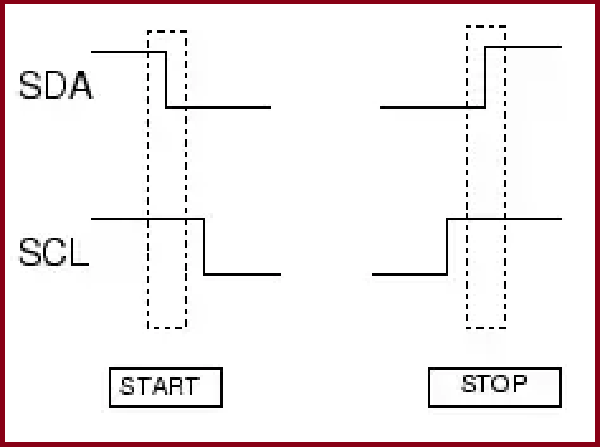
After the Start condition, the bus is considered as busy and can be used by another master only after a Stop condition is detected. After the Start condition, the master can generate a repeated Start. This is equivalent to a normal Start and is usually followed by the slave I2C address.
Microcontrollers that have dedicated I2C hardware can easily detect bus changes and behave also as I2C slave devices. However, if the I2C communication is implemented in software, the bus signals must be sampled at least two times per clock cycle in order to detect necessary changes.
I2C Data Transfer
The first thing that will happen is that the master will send out a start sequence. This will alert all the slave devices on the bus that a transaction is starting and they should listen in incase it is for them. Next the master will send out the device address. The slave that matches this address will continue with the transaction, any others will ignore the rest of this transaction and wait for the next. Having addressed the slave device the master must now send out the internal location or register number inside the slave that it wishes to write to or read from. This number is obviously dependant on what the slave actually is and how many internal registers it has. Some very simple devices do not have any, but most do, including all of our modules. Our CMPS03 has 16 locations numbered 0-15. The SRF08 has 36. Having sent the I2C address and the internal register address the master can now send the data byte (or bytes, it doesn’t have to be just one). The master can continue to send data bytes to the slave and these will normally be placed in the following registers because the slave will automatically increment the internal register address after each byte. When the master has finished writing all data to the slave, it sends a stop sequence which completes the transaction. So to write to a slave device:
- Send a start sequence
- Send the I2C address of the slave with the R/W bit low (even address)
- Send the internal register number you want to write to
- Send the data byte
- [Optionally, send any further data bytes]
- Send the stop sequence.

Data on the I2C Protocol bus is transferred in 8-bit packets (bytes). There is no limitation on the number of bytes, however, each byte must be followed by an Acknowledge bit. This bit signals whether the device is ready to proceed with the next byte. For all data bits including the Acknowledge bit, the master must generate clock pulses. If the slave device does not acknowledges transfer this means that there is no more data or the device is not ready for the transfer yet. The master device must either generate the Stop or Repeated Start condition.
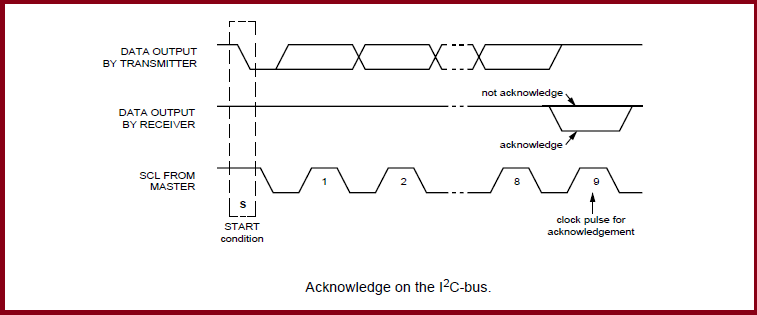
Synchronization
Each master must generate its own clock signal and the data can change only when the clock is low. For successful bus arbitration, a synchronized clock is needed. Once a master pulls the clock low it stays low until all masters put the clock into a high state. Similarly, the clock is in a high state until the first master pulls it low. This way by observing the SCL signal, master devices can synchronize their clocks.
Clock Stretching
As we told you earlier, the master device determines the clock speed. However, there are situations where an I2C slave is not able to co-operate with the clock speed given by the master and needs to slow down a little. This is done by a mechanism called Clock Stretching.
An I2C slave is allowed to hold down the clock if it needs to reduce the bus speed. The master, on the other hand, is required to read back the clock signal after releasing it to the high state and wait until the line has actually gone high.
Arbitration
For normal data transfer on the I2C bus, only one master can be active. If for some reason two masters initiate the I2C command at the same time, the arbitration procedure determines which master wins and can continue with the command. Arbitration is performed on the SDA signal while the SCL signal is high. Each master checks if the SDA signal on the bus corresponds to the generated SDA signal. If the SDA signal on the bus is low but it should be high, then this master has lost arbitration. Master I2C device that has lost arbitration can generate SCL pulses until the byte ends and must then release the bus and go into slave mode. The arbitration procedure can continue until all the data is transferred. This means that in a multi-master system each I2C master must monitor the I2C bus for collisions and act accordingly.
Clock Synchronization and Handshaking
Slave devices that need some time to process the received byte or are not ready yet to send the next byte, can pull the clock low to signal to the master that it should wait. Once the clock is released the master can proceed with the next byte.
Communication With 7-bit I2C Addresses

Each slave device on the bus should have a unique 7-bit address. The communication starts with the Start condition, followed by the 7-bit slave address and the data direction bit. If this bit is 0 then the master will write to the slave device. Otherwise, if the data direction bit is 1, the master will read from the slave device. After the slave address and the data direction is sent, the master can continue with reading or writing. The communication is ended with the Stop condition which also signals that the I2C bus is free. If the master needs to communicate with other slaves it can generate a repeated start with another slave address without the generation Stop condition. All the bytes are transferred with the MSB bit shifted first.
If the master only writes to the slave device then the data transfer direction is not changed.

If the master only needs to read from the slave device then it simply sends the I2C address with the R/W bit set to read. After this, the master device starts reading the data.
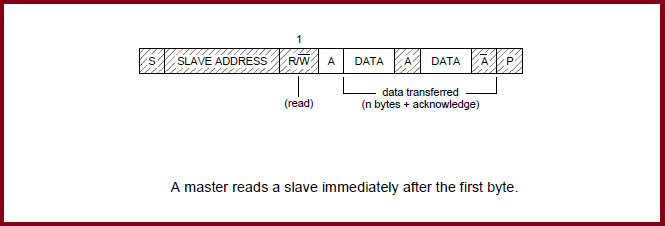
Sometimes the master needs to write some data and then read from the slave device. In such cases it must first write to the slave device, change the data transfer direction and then read the device. This means sending the I2C address with the R/W bit set to write and then sending some additional data like the register address. After the writing is finished the master device generates repeated start condition and sends the I2C address with the R/W bit set to read. After this, the data transfer direction is changed and the master device starts reading the data.

7-bit I2C Addressing
A slave address may contain a fixed and a programmable part. Some slave devices have few bits of the I2C address dependent on the level of address pins. This way it is possible to have on the same I2C bus more than one I2C device with the same fixed part of the I2C address.

The allocation of I2C addresses is administered by the I2C bus committee which takes care of the allocations. Two groups of 8 I2C addresses are reserved for future uses and one address is used for 10-bit I2C addressing.
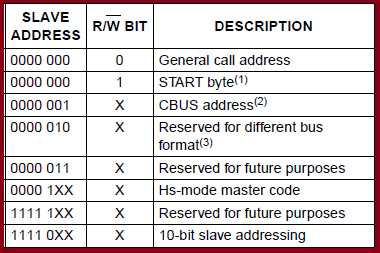
The general call address is used to address all devices on the slave bus. If any slave device doesn’t need to respond to such a call or a general call is not supported by the slave device, the call must be ignored. If the device supports general calls and wants to receive the data it must acknowledge the address and read the data as a slave receiver.
Start Byte
If the microcontroller has I2C hardware and the microcontroller acts as a slave then the software needs to do nothing to check the bus state. The I2C hardware will detect the Start condition, receive the I2C address, and interrupt the software if necessary. However, if the I2C interface is implemented by the software, the microcontroller has to sample the SDA line at least twice per clock pulse in order to detect changes. To simplify the detection of I2C commands on the bus in such cases, a special I2C address called Start byte is used. Such a start byte (0000 0001) is followed by an acknowledge pulse (for interface compatibility reasons). This combination holds the SDA line low for 7 clock pulses and allows simple detection of active I2C buses with lower sampling frequency.

Extension of the I2C Specifications
The standard mode of the I2C Protocol bus uses transfer rates up to 100 kbit/s and 7-bit addressing. Such an I2C interface is used by many hundred I2C Protocol-compatible devices from many manufacturers since its introduction in the 80s. However, with the advance of technology, needs for higher transfer rates and larger address space emerged. There are cases where a large amount of data needs to be transferred. Many complex embedded boards contain a large number of different I2C Protocol devices. In some cases, it is very hard to avoid address collisions since 7 bits for I2C addresses allow only 127 different addresses where only 112 can actually be used. Some I2C devices on the board, despite address pins, have the same address. This resulted in few upgrades to the standard-mode I2C specifications:
- Fast Mode – supports transfer rates up to 400 kbit/s
- High-speed mode (Hs-mode) – supports transfer rates up to 3.4 Mbit/s
- 10-bit addressing – supports up to 1024 I2C addresses
There can be any combination of the devices on the bus regardless of the supported speed and addressing. Fast mode devices are downward-compatible and can work with slower I2C controllers. However, most modern I2C controllers support all speeds and addressing modes.
The high-speed mode uses signals called SCLH and SDAH to emphasize the higher speed. These signals are usually separated from standard SDA and SCL lines. High-speed mode introduces also few differences (or improvements) in the specifications:
- Improved data and clock line output drivers
- Schmitt trigger and spike suppression circuits on data and clock inputs
- Clock synchronization and arbitration is not used
- Clock signal has 1 to 2 high/low ratio
10-bit I2C Addressing
10-bit addressing can be used together with 7-bit addressing since a special 7-bit address (1111 0XX) is used to signal a 10-bit I2C address. When a master wants to address a slave device using 10-bit addressing, it generates a start condition, then it sends 5 bits signaling 10-bit addressing (1111 0), followed by the first two bits of the I2C address and then the standard read/write bit.

If the master will write data to the slave device it must send the remaining 8 bits of slave address as the second byte.
If the master will read data from the slave device it must send the complete 10-bit address (two bytes) as for writing, then a repeated start is sent followed by the first address byte with read/write bit set to high to signal reading. After this procedure, the data can be read from the slave device.

Example Master Code
This example shows how to implement a software I2C master, including clock stretching. It is written in C for the PIC processor, but should be applicable to most processors with minor changes to the I/O pin definitions. It is suitable for controlling all of our I2C based robot modules. Since the SCL and SDA lines are open drain type, we use the tristate control register to control the output, keeping the output register low. The port pins still need to be read though, so they’re defined as SCL_IN and SDA_IN. This definition and the initialization is probably all you’ll need to change for a different processor.
#define SCL TRISB4 // I2C bus
#define SDA TRISB1 //
#define SCL_IN RB4 //
#define SDA_IN RB1 //
To initialize the ports set the output resisters to 0 and the tristate registers to 1 which disables the outputs and allows them to be pulled high by the resistors.
SDA = SCL = 1;
SCL_IN = SDA_IN = 0;
We use a small delay routine between SDA and SCL changes to give a clear sequence on the I2C bus. This is nothing more than a subroutine call and return.
void i2c_dly(void)
{
}
The following 4 functions provide the primitive start, stop, read and write sequences. All I2C transactions can be built up from these.
void i2c_start(void)
{
SDA = 1; // i2c start bit sequence
i2c_dly();
SCL = 1;
i2c_dly();
SDA = 0;
i2c_dly();
SCL = 0;
i2c_dly();
}
void i2c_stop(void)
{
SDA = 0; // i2c stop bit sequence
i2c_dly();
SCL = 1;
i2c_dly();
SDA = 1;
i2c_dly();
}
unsigned char i2c_rx(char ack)
{
char x, d=0;
SDA = 1;
for(x=0; x<8; x++) {
d <<= 1;
do {
SCL = 1;
}
while(SCL_IN==0); // wait for any SCL clock stretching
i2c_dly();
if(SDA_IN) d |= 1;
SCL = 0;
}
if(ack) SDA = 0;
else SDA = 1;
SCL = 1;
i2c_dly(); // send (N)ACK bit
SCL = 0;
SDA = 1;
return d;
}
bit i2c_tx(unsigned char d)
{
char x;
static bit b;
for(x=8; x; x--) {
if(d&0x80) SDA = 1;
else SDA = 0;
SCL = 1;
d <<= 1;
SCL = 0;
}
SDA = 1;
SCL = 1;
i2c_dly();
b = SDA_IN; // possible ACK bit
SCL = 0;
return b;
}
The 4 primitive functions above can easily be put together to form complete I2C transactions. Here's and example to start an SRF08 ranging in cm:
i2c_start(); // send start sequence
i2c_tx(0xE0); // SRF08 I2C address with R/W bit clear
i2c_tx(0x00); // SRF08 command register address
i2c_tx(0x51); // command to start ranging in cm
i2c_stop(); // send stop sequence
Now after waiting 65mS for the ranging to complete (I've left that to you) the following example shows how to read the light sensor value from register 1 and the range result from registers 2 & 3.
i2c_start(); // send start sequence
i2c_tx(0xE0); // SRF08 I2C address with R/W bit clear
i2c_tx(0x01); // SRF08 light sensor register address
i2c_start(); // send a restart sequence
i2c_tx(0xE1); // SRF08 I2C address with R/W bit set
lightsensor = i2c_rx(1); // get light sensor and send acknowledge. Internal register address will increment automatically.
rangehigh = i2c_rx(1); // get the high byte of the range and send acknowledge.
rangelow = i2c_rx(0); // get low byte of the range - note we don't acknowledge the last byte.
i2c_stop(); // send stop sequence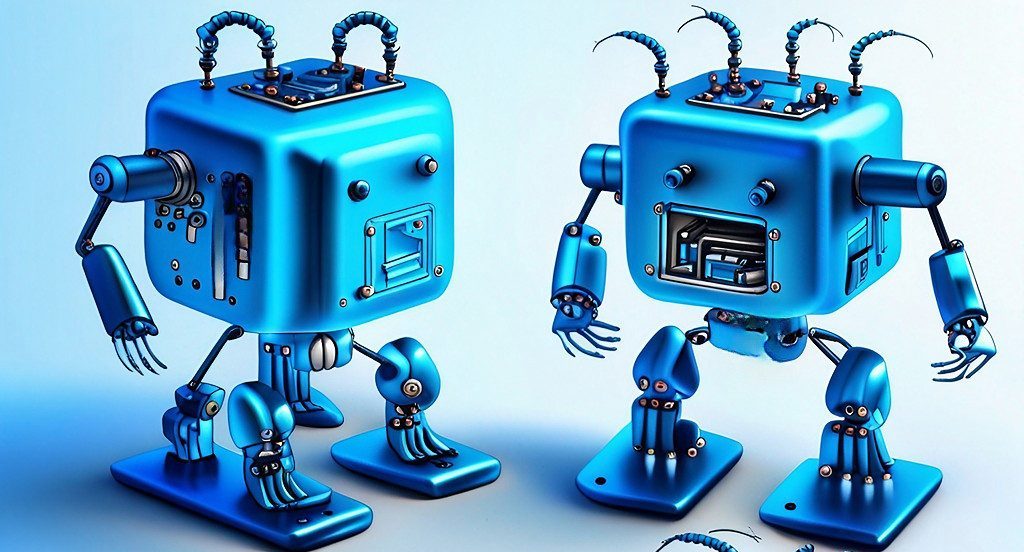
Leave a comment